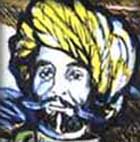|
To
offset the barren colorless landscape and the monotony
of its cloudless sky, the people of Rajashtan show
a distinct preference for bright costumes. From the
simple village folk or tribal belle to the Raja's
and Rani's, the preferred colors are bright red, dazzling
yellow, lively green or brilliant orange, highlighted
by a lavish use of sparkling gold and silver zari
or gota. The dyers of Rajasthan and neighboring Gujarat
(many of whom migrated here) were masters of their
craft from the dawn of history. Their unsurpassed
skill is still evident in the costumes worn by the
Rajasthani people both
rich and poor.
|
|
|
Royal
Wardrobe - The state records of Jaipur mention
special departments in charge of royal costumes While the
Ranghkhana and the Chhapakhana are departments that took
care of dyeing and printing the fabrics respectively. The
siwankhana ensured its immaculate tailoring Two special
sections, the toshakhanaand the kapaddwadra, took care of
the daily wear and formal costumes of the king.
|
|
Traditional
textiles - Rasjasthani
daily wear such as Saris, Odhnis and Turbans are often made from
textiles using either blockprinted (above) or tie-and-dye techniques.
|
|
Rajput
Costumes - The Rajput kings, owing to their close
proximity to the Mughal court style in their formal dress.
Richly brocaded material from Banaras and Gujarat, Embroidered
and woven Kashmiri shawls and delicate cottons from Chanderi
and Dhaka were procured at great cost. This formal dress
made for Maharaja Bane Singh of Alwar (1815-57) shows a
strange mixture of Mughal and Traditional styles.
|
Men's
Attire - The turban, variously called Pagari,
Pencha, Sela or Safa depending on style, an Angrakhi or
Achakan as the upper garment and Dhoti or Pyjama as the
lower garment make up the male outfit.
Turban
Styles - Varying styles of turban denote region
and caste. These variations are known by different names
such as Pagari and Safa. A Pagari is usually 82 feet long
and 8 inches wide. A safa is shorter and broader. The common
man wears turbans of one color, while the elite wear designs
and colors according to the occasion.
|
|
Tying
the Turban
|
|
Achieving
different styles with just a length of material
requires great skill. Specialists in this art,
called pagribands, were employed by the royal
courts, but Rajasthanis generally take pride in
practicing and perfecting the art of turban-tying
themselves.
|
|
|
|
|
|
|
Women's
Attire - The standard design is a four-piece dress
which includes the ghagra (skirt), the odhni(head cloth), the
kurti (like a bra) and the kanchi (a long, loose blouse). ODHNI-
An odhni is 10 feet long and 5 feet wide, One corner is tucked
in the skirt while the other end is taken over the head and
right shoulder. Colors and motifs are particular to caste, type
of costume and occasion. Both Hindu and Muslims women wear odhnis.
|
Pila
- An odhni with a yellow background and a central lotus motif
in red called a pila, is a traditional gift of parent to their daughter
on the birth of a son.
|



